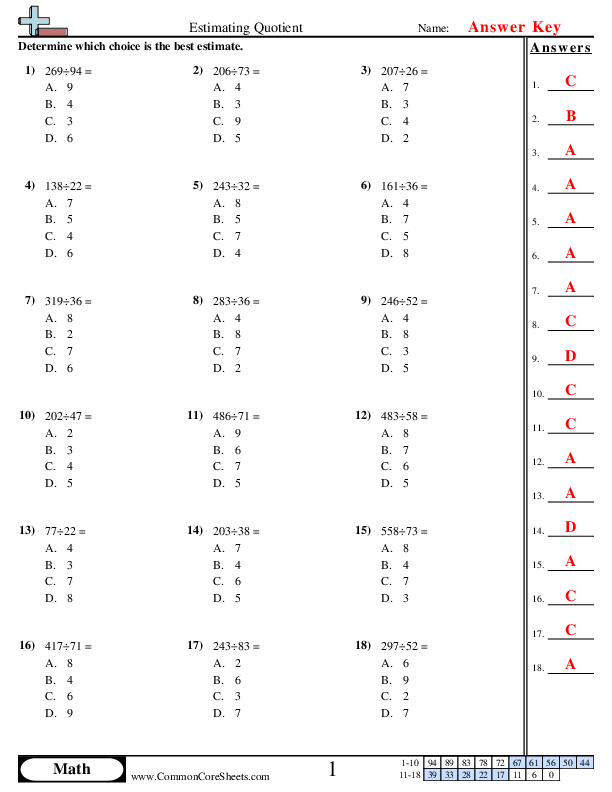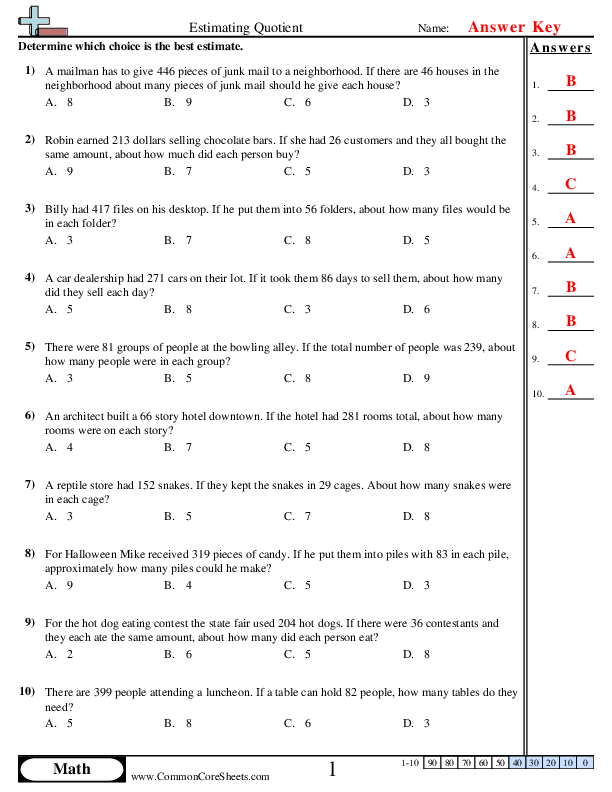Looking for the best division worksheets on the internet? Look no further! We've got you covered with our free, printable division worksheets. Our division worksheets range from the basics of visual problems to more complex long division and problems that are relative to multiplication. With our helpful resources, your students will understand key concepts such as multiples and remainders while having fun learning math. Take a look at our selection of free division worksheets today – it's sure to help your students practice and learn with confidence.
Browse Sheets By Problem Type
×

3 Digit ÷ 2 Digit
4nbt6


×
Description:
"This worksheet is designed to enhance children's math skills, focusing on estimating quotients. Comprising 18 engaging problems, it exposes kids to practical applications of division. The customizable format allows adaptation to flashcards, suiting varied learning styles, or use in distance learning environments. A resourceful instrument for systematic practice and reinforcing mathematical concepts."

×
Student Goals:
Improving Estimation SkillsAfter successfully completing the worksheet, children would have significantly enhanced their skills of estimating quotients. Estimating is an invaluable attribute not just in math, but in real-life scenarios as well, helping kids appraise situations and make swift decisions. This worksheet equips students with the ability to swiftly approximate the result of a division problem without fully calculating it.Boosting Division ProficiencyWorking on this worksheet implies that your child is polishing their division skills. Being faced with multiple division problems aids in understanding how division works and eventually leads towards a steady proficiency in the operation. The repetitive tasks from this worksheet will act as a push into a comfort zone where dividing numbers becomes second nature.Reinforcing Arithmetic SkillsCompleting the worksheet will enforce and strengthen the overall arithmetic skills of the student. As division is one of the four fundamental operations of arithmetic, understanding it forms an integral part of elementary number manipulation. With these steady exercises, a child will be more proficient not only in division but in overall numeracy.Building ConfidenceSuccessfully completing the worksheet will undeniably instill a convincing dose of self-confidence in any student. Accomplishing such a plethora of division exercises is fairly challenging. Grappling and overcoming these challenges will signify the child's growing competence, thus strengthening their conviction in their own abilities.Enhancing Problem-Solving AbilitiesWith every problem solved in this worksheet, the student is developing strong problem-solving skills. These skills are not limited to math alone, but also enhance conceptual thinking and reasoning attitude. Hence, through this worksheet, they are learning to work their way around problems and finding solutions through logical steps and analytical thinking.Preparation for Advanced MathBy understanding and mastering the concept of division through this worksheet, a student is taking a significant step towards understanding more complex mathematical concepts. Advanced mathematics rely heavily on these basic operations; hence, mastering them is a fundamental necessity. With the exemplary problem-solving practiced here, the unnamed student is essentially preparing their mental ground for more challenging, advanced mathematical topics.



Word 3 ÷ 2
4nbt6


×
Description:
"This worksheet is designed to challenge children in the field of mathematics, specifically focusing on estimating quotients. Students are invited to venture into real-life scenarios involving financial expenditures and earnings, guiding them to estimate division answers. With this adjustable tool, educators may customize problems, convert them into flash cards, or integrate within distance learning programs, effectively accommodating various learning preferences and environments."

×
Student Goals:
Mathematical ComprehensionUpon completing this worksheet, students should demonstrate an improved understanding of basic mathematical operations, particularly in division. They should be able to apply principles of division in estimating quotients - even in real-life scenarios involving weights, quantities, and numbers. This represents a fundamental building block of mathematical competence and a vital skill in everyday numerical situations.Problem-Solving SkillsChildren should be able to develop effective problem-solving strategies. By estimating the quotient in different scenarios, they are not only enhancing their calculation skills, but are also learning to approach problems logically and systematically. This is a crucial skill that goes beyond mere academics and can be translated into various aspects of life.Critical ThinkingCompletion of the worksheet should also foster enhanced critical thinking skills. Students must understand the problem placed before them and identify the best way to estimate the answer. This encourages them to delve deeper into the problem, analysing it from different perspectives instead of merely seeking a clear-cut answer. Rigorous exercises in critical thinking such as these can substantially assist cognitive development in children.Application in Real-Life ContextFollowing the completion of this worksheet, students should be able to apply these mathematical concepts in real-life contexts. The problems given are rooted in practical situations, intending to show students that the skills they’re learning aren't just abstract concepts, but tools they can use in everyday life. Thus, they should be able to use their division skills to estimate quantities in various real-life contexts.Increased ConfidenceSuccessfully solving these problems should imbue students with a fresh boost of confidence. Mastering a concept and applying it effectively can significantly improve self-esteem and the belief in one's abilities. This worksheet is thus uniquely valuable as a tool to foster greater confidence in mathematical skills, encouraging students to engage more enthusiastically in future mathematical tasks.



